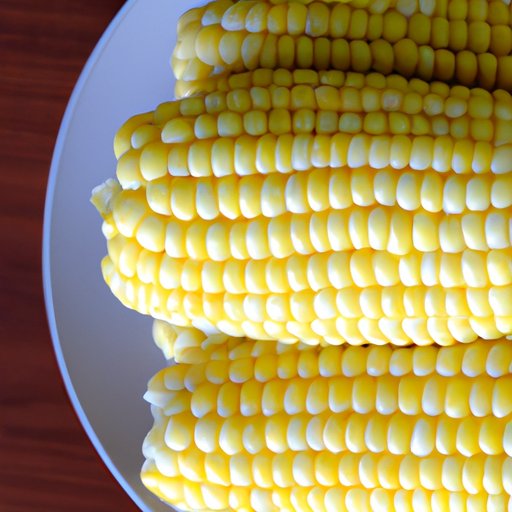
Introduction
Corn is a widely popular and versatile crop that can be cooked in many different ways. But have you ever wondered if you can eat it raw? Raw corn might seem tough and unappetizing to some, but it can actually be a tasty and nutritious snack if eaten properly. In this article, we will explore the pros and cons of eating corn raw, its health benefits, and ways to incorporate it in your cooking.
Raw or Cooked: The Pros and Cons of Eating Corn Straight from the Cob
One of the main advantages of eating raw corn is the convenience and simplicity of its preparation. You can simply peel back the husk, remove the silk, and bite straight into the crunchy kernels. Raw corn also has a sweeter taste and crunchier texture compared to cooked corn, which some people prefer.
On the other hand, eating raw corn can be risky if the corn is not fresh or properly stored. Old or contaminated corn can contain harmful bacteria that can cause food poisoning. Additionally, raw corn can be difficult for some individuals to digest, leading to stomach discomfort or flatulence.
Beyond Boiling: Exploring the Deliciousness of Fresh, Raw Corn
Raw corn can be enjoyed in various ways beyond eating it straight off the cob. You can slice off the kernels and mix them into salads, salsas, or dips. Raw corn can also be added to smoothies or blended into a refreshing summer drink.
The taste and texture of raw corn can vary depending on the variety and freshness of the corn. Generally, raw corn has a sweeter and nuttier taste with a crisp and juicy mouthfeel. Compared to cooked corn, which can be starchy and mushy, raw corn has a fresh and lively flavor that can elevate any dish.
Eating Corn Like a Pro: How to Properly Enjoy a Raw Corn on the Cob
If you prefer to eat raw corn on the cob, there are a few things to keep in mind. Firstly, make sure the corn is fresh and of good quality. This means that the husk should be bright green, tightly wrapped, and free of any mold or insect damage. Secondly, peel back the husk and silk carefully, making sure not to damage the kernels. Finally, bite into the corn from top to bottom, rotating the cob as needed.
Another tip for getting the most flavor out of your raw corn is to sprinkle it with some salt, lemon juice, or chili powder. This can enhance the natural sweetness of the corn while adding a tangy or spicy kick.
Corn: The Surprising Health Benefits of Eating it Raw
Aside from its delicious taste, raw corn also offers many nutritional benefits. Raw corn is an excellent source of fiber, which can improve digestion and lower the risk of chronic diseases such as heart disease and diabetes. It is also rich in antioxidants, which can protect the body from harmful free radicals and reduce inflammation.
Compared to cooked corn, which can lose some of its nutrients during the cooking process, raw corn retains most of its vitamins and minerals. Eating raw corn can provide your body with essential nutrients such as vitamin C, vitamin B6, and folate.
From Salad to Salsa: Creative Ways to Use Raw Corn in Your Cooking
Raw corn can be a versatile ingredient that can add flavor, texture, and nutrition to many dishes. Here are some creative ways to use raw corn in your cooking:
- Make a fresh corn salad by tossing raw corn kernels with diced tomatoes, cucumbers, and avocado.
- Add raw corn to your favorite guacamole or salsa recipe for an extra crunch.
- Blend raw corn kernels with fresh herbs, garlic, and olive oil to make a flavorful corn pesto.
- Grill or sauté raw corn for a tasty side dish or topping for tacos or quesadillas.
- Make a sweet corn pudding or custard by blending raw corn kernels with milk, sugar, and eggs.
Raw Corn vs Cooked Corn: Which is the Healthiest and Tastiest Option?
Both raw and cooked corn have their own pros and cons, and the choice ultimately depends on personal preference and nutritional goals. If you prefer a sweeter and crunchier corn, raw corn might be the better option for you. However, if you want to enjoy a softer and more savory corn, cooked corn might be the way to go.
In terms of nutrition, raw corn generally retains more vitamins and minerals than cooked corn. However, cooked corn can be easier to digest for some individuals and may offer other health benefits such as improved antioxidant absorption.
Conclusion
In conclusion, eating raw corn can be a tasty and healthy way to enjoy this versatile crop. Whether you eat it straight off the cob or use it as an ingredient in your cooking, raw corn can provide many nutritional benefits while adding a fresh and lively flavor to your meals. Just make sure to choose fresh and high-quality corn and properly store it to avoid any food safety issues.




